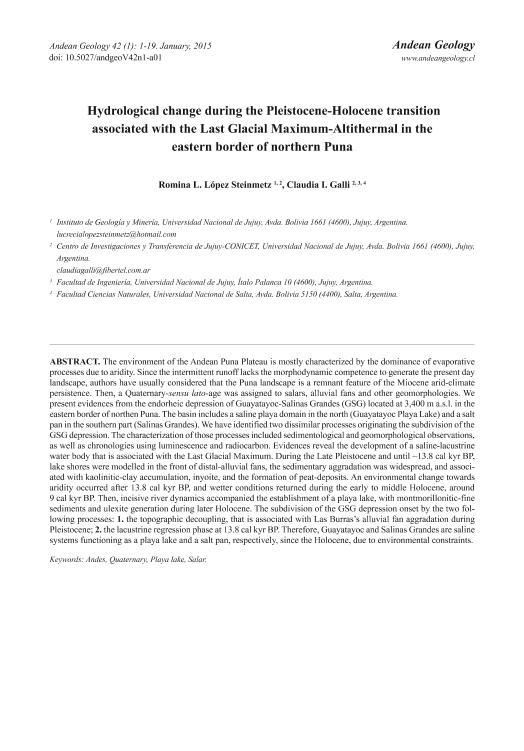Artículo
Hydrological change during the pleistocene-holocene transition associated with the last glacial maximum-altithermal in the eastern border of northern Puna
Título:
Cambio hidrológico asociado al Último Máximo Glacial-Altitermal durante la transición Pleistoceno-Holoceno en el borde oriental de Puna Norte
Fecha de publicación:
01/2015
Editorial:
Servicio Nacional de Geología y Minería
Revista:
Andean Geology
ISSN:
0718-7092
e-ISSN:
0718-7106
Idioma:
Inglés
Tipo de recurso:
Artículo publicado
Clasificación temática:
Resumen
The environment of the Andean Puna Plateau is mostly characterized by the dominance of evaporative processes due to aridity. Since the intermittent runoff lacks the morphodynamic competence to generate the present day landscape, authors have usually considered that the Puna landscape is a remnant feature of the Miocene arid-climate persistence. Then, a Quaternary-sensu lato-age was assigned to salars, alluvial fans and other geomorphologies. We present evidences from the endorheic depression of Guayatayoc-Salinas Grandes (GSG) located at 3,400 m a.s.l. in the eastern border of northen Puna. The basin includes a saline playa domain in the north (Guayatayoc Playa Lake) and a salt pan in the southern part (Salinas Grandes). We have identified two dissimilar processes originating the subdivision of the GSG depression. The characterization of those processes included sedimentological and geomorphological observations, as well as chronologies using luminescence and radiocarbon. Evidences reveal the development of a saline-lacustrine water body that is associated with the Last Glacial Maximum. During the Late Pleistocene and until ~13.8 cal kyr BP, lake shores were modelled in the front of distal-alluvial fans, the sedimentary aggradation was widespread, and associated with kaoliniticclay accumulation, inyoite, and the formation of peat-deposits. An environmental change towards aridity occurred after 13.8 cal kyr BP, and wetter conditions returned during the early to middle Holocene, around 9 cal kyr BP. Then, incisive river dynamics accompanied the establishment of a playa lake, with montmorillonitic-fine sediments and ulexite generation during later Holocene. The subdivision of the GSG depression onset by the two following processes: 1. the topographic decoupling, that is associated with Las Burras’s alluvial fan aggradation during Pleistocene; 2. the lacustrine regression phase at 13.8 cal kyr BP. Therefore, Guayatayoc and Salinas Grandes are saline systems functioning as a playa lake and a salt pan, respectively, since the Holocene, due to environmental constraints.
Palabras clave:
Andes
,
Playa Lake
,
Quaternary
,
Salar
Archivos asociados
Licencia
Identificadores
Colecciones
Articulos(SEDE CENTRAL)
Articulos de SEDE CENTRAL
Articulos de SEDE CENTRAL
Citación
López Steinmetz, Romina Lucrecia; Galli, Claudia Inés; Hydrological change during the pleistocene-holocene transition associated with the last glacial maximum-altithermal in the eastern border of northern Puna; Servicio Nacional de Geología y Minería; Andean Geology; 42; 1; 1-2015; 1-19
Compartir
Altmétricas




